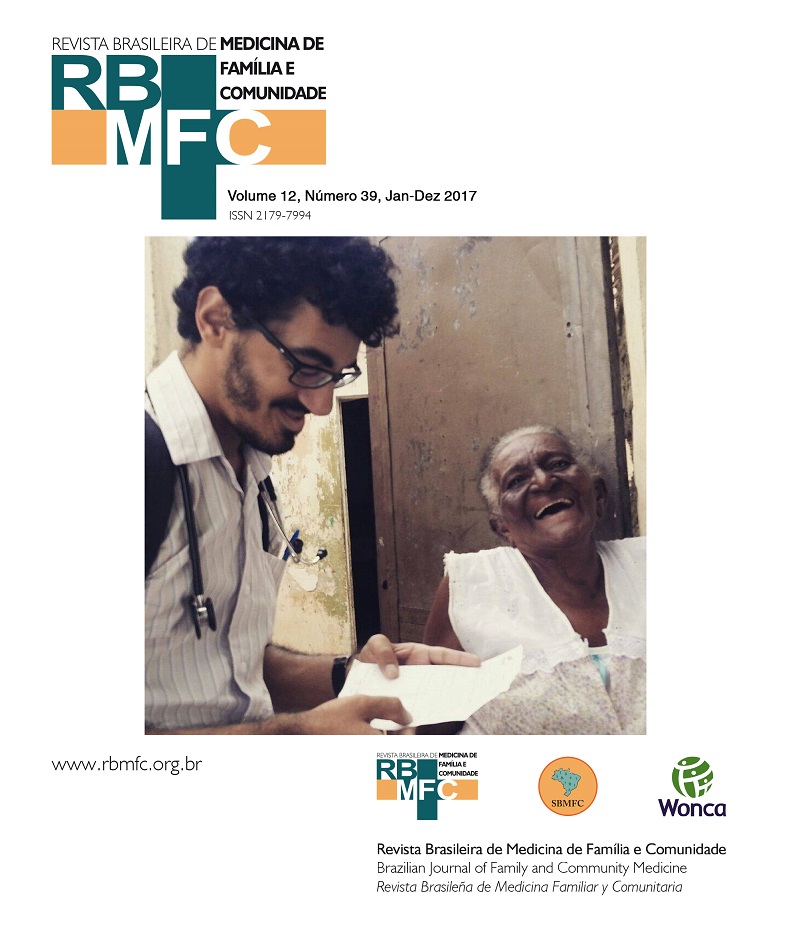Analysis of frailty syndrome in primary care - Cross sectional study
DOI:
https://doi.org/10.5712/rbmfc12(39)1353Keywords:
Frail Elderly. Primary Health Care. ComorbidityAbstract
Objective: To assess the prevalence of frailty syndrome in elderly patients in primary health care. Methods: A cross-sectional study that included a sample of 306 individuals of both sexes, aged 65 years or older, living in the neighborhood of Jardim Camanducaia, city of Amparo, SP, Brazil. We evaluated data on sex, age, chronic disease, cognitive performance, and the phenotype of frailty, which considered grip strength, gait speed, level of physical activity, weight loss and fatigue. Results: It was found a predominance of females (60%) in the sample. 21.5% of the studied patients were characterized as frail, 71.5% of elderly people have been classified as pre-frail, and 6% of the sample were categorized as non-frail. Conclusion: There was a high prevalence of frail and pre-frail elderly patients, and this finding points to the need for periodic evaluation of the elderly by a multidisciplinary team. Thus, frailty could be prevented, in order to reduce or minimize adverse outcomes concerning health.
Downloads
Metrics
References
Brasil. Ministério da Saúde. Secretaria de Atenção à Saúde. Departamento de Atenção Básica. Cadernos de Atenção Básica: Envelhecimento e Saúde da Pessoa Idosa. Brasília: Ministério da Saúde; 2006.
Ramos LR. Fatores determinantes do envelhecimento saudável em idosos residentes em centro urbano: Projeto Epidoso, São Paulo. Cad Saúde Pública. 2003;19(3):793-7. DOI: https://doi.org/10.1590/S0102-311X2003000300011
Woodhouse KW, Wynne H, Baillie S, James OF, Rawlins MD. Who are the frail elderly? Q J Med. 1988;68(255):505-6.
Fried LP, Tangen CM, Walston J, Newman AB, Hirsch C, Gottdiener J, et al.; Cardiovascular Health Study Collaborative Research Group. Frailty in older adults: evidence for a phenotype. J Gerontol A Biol Sci Med Sci. 2001;56(3):M146-56. DOI: http://dx.doi.org/10.1093/gerona/56.3.M146 DOI: https://doi.org/10.1093/gerona/56.3.M146
Rockwood K, Howlett SE, MacKnight C, Beattie BL, Bergman H, Hébert R, et al. Prevalence, attributes, and outcomes of fitness and frailty in community-dwelling older adults: report from the Canadian study of health and aging. J Gerontol A Biol Sci Med Sci. 2004;59(12):1310-7. DOI: http://dx.doi.org/10.1093/gerona/59.12.1310 DOI: https://doi.org/10.1093/gerona/59.12.1310
Rolfson DB, Majumdar SR, Tsuyuki RT, Tahir A, Rockwood K. Validity and reliability of the Edmonton Frail Scale. Age Ageing. 2006;35(5):526-9. DOI: http://dx.doi.org/10.1093/ageing/afl041 DOI: https://doi.org/10.1093/ageing/afl041
Fabrício-Wehbe SC, Schiaveto FV, Vendrusculo TR, Haas VJ, Dantas RA, Rodrigues RA. Cross-cultural adaptation and validity of the ‘Edmonton Frail Scale - EFS’ in a Brazilian elderly sample. Rev Lat Am Enfermagem. 2009;17(6):1043-9. DOI: https://doi.org/10.1590/S0104-11692009000600018
Macedo C, Najas M, Gazzola JM. Síndrome da fragilidade no idoso: importância da fisioterapia. Arq Bras Ciênc Saúde. 2008;33(3):177-84. DOI: https://doi.org/10.7322/abcs.v33i3.154
Brasil. IBGE. Censo demográfico. [Internet]. [acesso 2016 Jan 21]. Disponível em: http://www.cidades.ibge.gov.br
Folstein MF, Folstein SE, McHugh PR. “Mini-mental state”. A practical method for grading the cognitive state of patients for the clinician. J Psychiatr Res. 1975;12(3):189-98. DOI: http://dx.doi.org/10.1016/0022-3956(75)90026-6 DOI: https://doi.org/10.1016/0022-3956(75)90026-6
Brucki SMD, Nitrini R, Caramelli P, Bertolucci PHF, Okamoto IH. Sugestões para o uso do mini-exame do estado mental no Brasil. Arq Neuro-Psiquiatr. 2003;61(3B):777-81. DOI: http://dx.doi.org/10.1590/S0004-282X2003000500014 DOI: https://doi.org/10.1590/S0004-282X2003000500014
Bertolucci PHF, Brucki SMD, Campacci SR, Juliano Y. O Mini-Exame do Estado Mental em uma população geral: impacto da escolaridade. Arq Neuro-Psiquiatr. 1994;52(1):1-7. DOI: http://dx.doi.org/10.1590/S0004-282X1994000100001 DOI: https://doi.org/10.1590/S0004-282X1994000100001
Falsarella GR, Gasparotto LP, Barcelos CC, Coimbra IB, Moretto MC, Pascoa MA, et al. Body composition as a frailty marker for the elderly community. Clin Interv Aging. 2015;10:1661-6. DOI: http://dx.doi.org/10.2147/CIA.S84632 DOI: https://doi.org/10.2147/CIA.S84632
Lustosa LP, Pereira DS, Dias RC, Britto RR, Parentoni AN, Pereira LSM. Tradução e adaptação transcultural do Minnesota Leisure Time Activities Questionnaire em idosos. Geriatr Gerontol Aging. 2011;5(2):57-65.
Neri AL, Yassuda MS, Araújo LF, Eulálio AC, Cabral BE, Siqueira MEC, et al. Metodologia e perfil sociodemográfico, cognitivo e de fragilidade de idosos comunitários de sete cidades brasileiras: Estudo FIBRA. Cad Saúde Pública. 2013;29(4):778-92. DOI: http://dx.doi.org/10.1590/S0102-311X2013000800015 DOI: https://doi.org/10.1590/S0102-311X2013000800015
VieiraI RA, Guerra RO, Giacomin KC, Vasconcelos KSS, Andrade ACS, Pereira LSM, et al. Prevalência de fragilidade e fatores associados em idosos comunitários de Belo Horizonte, Minas Gerais, Brasil: dados do estudo FIBRA. Cad Saúde Pública. 2013;29(8):1631-43. DOI: http://dx.doi.org/10.1590/S0102-311X2013001200015 DOI: https://doi.org/10.1590/S0102-311X2013001200015
Sousa AC, Dias RC, Maciel AC, Guerra RO. Frailty syndrome and associated factors in community-dwelling elderly in Northeast Brazil. Arch Gerontol Geriatr. 2012;54(2):e95-e101. DOI: https://doi.org/10.1016/j.archger.2011.08.010
Tribess S, Oliveira RJ. Síndrome da fragilidade biológica em idosos: revisão sistemática. Rev Salud Pública. 2011;13(5):853-64. DOI: http://dx.doi.org/10.1590/S0124-00642011000500014 DOI: https://doi.org/10.1590/S0124-00642011000500014
Sternberg SA, Wershof Schwartz A, Karunananthan S, Bergman H, Mark Clarfield A. The identification of frailty: a systematic literature review. J Am Geriatr Soc. 2011;59(11):2129-38. DOI: http://dx.doi.org/10.1111/j.1532-5415.2011.03597.x DOI: https://doi.org/10.1111/j.1532-5415.2011.03597.x
Downloads
Published
How to Cite
Issue
Section
License
By submitting a manuscript to the RBMFC, authors retain ownership of the copyright in the article, and authorize RBMFC to publish that manuscript under the Creative Commons Attribution 4.0 license and identify itself as the vehicle of its original publication.















